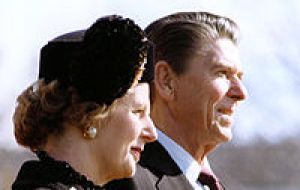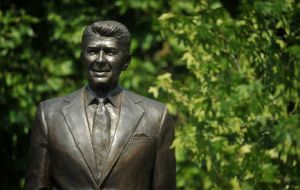MercoPress. South Atlantic News Agency
Statue of President Reagan, crucial ally of Mrs Thatcher, unveiled in London
 Mrs Thatcher and President Reagan whose formidable joint approach brought down the collapse of the Soviet empire
Mrs Thatcher and President Reagan whose formidable joint approach brought down the collapse of the Soviet empire  The 10-foot (three-metre) statue of Reagan was unveiled to mark 100 years since his birth (Photo AFP)
The 10-foot (three-metre) statue of Reagan was unveiled to mark 100 years since his birth (Photo AFP) A statue of former US President Ronald Reagan has been unveiled at a ceremony outside the American embassy in central London. The invited guests include former UK Prime Minister Baroness Thatcher - who was a close ally of Reagan when they were both in power in the 1980s.
President Regan proved crucial for the UK in 1982 on retaking the Falkland Islands from the Argentine military invasion. The US provided missiles, equipment, intelligence and political support to its main NATO ally.
The 10-foot bronze statue was specially commissioned to “recognise Mr Reagan's contribution to ending the Cold War”. A piece of the Berlin Wall will be installed in front of the plinth.
The statue stands outside the US Embassy in Grosvenor Square, opposite the statue of President Dwight Eisenhower.
Lady Thatcher famously described Mr Reagan as “the second most important man” in her life. She once said he had “a higher claim than any other leader to have won the Cold War for liberty and he did it without a shot being fired”.
Ahead of the unveiling - which falls on US Independence Day - UK Foreign Secretary William Hague read out a tribute from Lady Thatcher, who was unable to attend because of her frail health.
Lady Thatcher said of him: “Ronald Reagan was a great president and a great man. A true leader for our times. He held clear principles and acted upon them with purpose.
”Through his strength and his conviction he brought millions of people to freedom as the iron curtain came down. It was a pleasure to be his colleague and his friend and I hope this statue will be a reminder to future generations of the debt we owe him.“
Mr Hague himself described Mr Reagan as ”one of America's greatest sons and a giant of 20th Century history“.
Mr Reagan famously described the Soviet Union as the ”evil empire“ and kept up a hard-line strategy towards it, escalating the arms race with the USSR during his firm term in office.
However, during his second term, and after encouragement from Lady Thatcher, Mr Reagan employed diplomatic means as well, meeting Soviet leader Mikhail Gorbachev on a number of occasions and putting pressure on him, both publicly and privately, to reform.
Mr Reagan left the White House in January 1989, shortly before the collapse of communism.
Lord Howe, who was foreign secretary under Lady Thatcher, told BBC Radio 4's Today program that Mr Reagan was ”a formidable leader“ who did play a crucial part in ending the Cold War.
”Margaret Thatcher saw his potential in that respect as soon as he was elected,“ he said.
”She said that his election was a watershed in world politics and she saw it as her duty to do all she could to reinforce his bold strategy.“
Lord Howe added: ”Many people did underestimate him, but he was, in fact, a man of authority, warmth, determination.
“The Reagan doctrine was what he annunciated - that the West would not abandon those countries which had communism forced upon them - so he made a decisive impact on the world in which we live.”
Mr Reagan died in 2004, aged 93, after suffering from Alzheimer's disease for many years. (BBC).-




Top Comments
Disclaimer & comment rules-

-

-

Read all commentsset in stone , unity friendship and loyalty,
Jul 05th, 2011 - 08:53 pm 0In response of that Mr Obama sent Winston Chrchill bust back to England.
Jul 06th, 2011 - 04:58 pm 0http://www.telegraph.co.uk/news/worldnews/barackobama/4623148/Barack-Obama-sends-bust-of-Winston-Churchill-on-its-way-back-to-Britain.html
In responce to this now, he sent that back two years ago.
Jul 06th, 2011 - 05:40 pm 0Not very bright, are you?
Commenting for this story is now closed.
If you have a Facebook account, become a fan and comment on our Facebook Page!